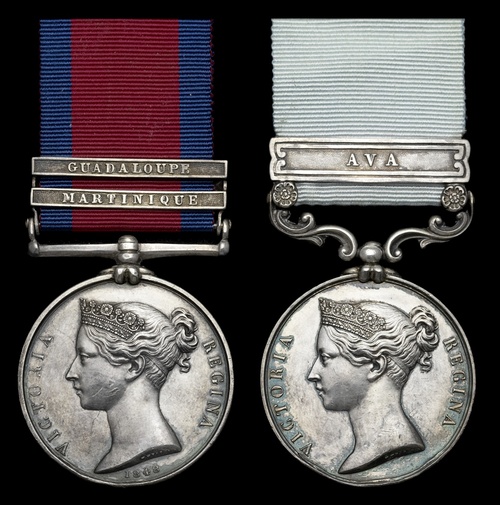Auction: 25001 - Orders, Decorations and Medals
Lot: 47
(x) 'A charming & handsome old man with one arm.
So wrote the niece of the gallant Colonel Knox
An outstanding campaign pair awarded to Colonel K. Barrett, 13th Regiment of Foot (1st Somersetshire) (Prince Albert's Regiment of Light Infantry), a long-served and most gallant officer who served on campaign in the Caribbean, Upper Canada and Burma - having his arm blown off in the attack on the Great Pagoda in July 1825 in the last
Military General Service 1793-1814, 2 clasps, Martinique, Guadaloupe (Knox Barrett, Ensn. 13th Foot.); Army of India 1799-1826, 1 clasp, Ava (Bt. Captn. K. Barrett, 13th Foot.), short-hyphen reverse, officially impressed naming, heavy edge bruising, very fine (2)
Knox Barrett was born circa 1783, the son of William Barrett, High Sheriff of Sligo, of Culleenamore House. The Sligo Independant of July 1882 gives more detail:
' He joined in 1805 from the North Mayo Militia, obtaining an ensigncy in the gallant 13th Regiment of Foot. This regiment, when in India saw much service, and Colonel Barrett, then a Lieutenant, showed much pluck and coolness on the battle field. At Rangoon, when the English army under General Dale fought well and bravely, Colonel Barrett led his Company in the thickest of the fight, and had his right arm shot off. He was specially mentioned by his Colonel, afterwards the great and good General Havelock as being a brave officer. Of course, the loss of his arm obliged him to retire from the Army, and General Havelock, whose friend and companion he was, parted from him with regret. He possessed medals and claps for Ava, Guadeloupe, Martinique, India etc. Since he left the army, he came to reside in Sligo.'
Barrett has a remarkable record of service in the Caribbean, North America and in India. Having shared in the actions at Martinique in October 1809, he was present at the capture of Guadaloupe and was then subsequently posted to Upper Canada with his unit. Their Light Company was stationed at le Aux Noix and a detachment went to the blockhouse of Lacolle Mills - when they shared in the famous defence of that place in March 1814.
Furthermore, Barrett would have been with his unit when they crossed Lake Champlain to attack Plattsburgh in New York, sharing in the final acts of the War of 1812. They departed the scene in July 1815. He would then share in the events in India, being unfortunate to have his '...arm blown off' during the attack on the Great Pagoda in the First Anglo-Burmese War. On 5 July 1825 the unit also suffered one man killed and seventeen other ranks wounded in action besides Barrett.
Retired on account of his wounds, he was provided with a pension of £70 for his wounds. Returned to his native Sligo, he took up various posts, including as Justice of the Peace, Superintendent of the gaol, a member of the Sligo Harbor Commission and sat on the Dispensary Commission. Having married Anne Rice in 1827, the pair had no children but were always known for their generosity to their numerous nephews and nieces. The good Colonel died on 10 July 1882 and is buried in the family tomb at St John's Churchyard. His obituary notice gives the final word:
'Our obituary notices of to-day announce the death of this gentleman who lived to a patriarchal age, being nearly a century old when he breathed his last at his residence, Rathanna, near this town. It may be well said that by his death a link connecting the present generation with the past – the long past – a severed, for when many grandfathers of today were leading strings Colonel Barrett was fighting for his King and country on the burning plains of India...
In private life he was distinguished for his mildness of disposition and goodness of heart.'
Subject to 5% tax on Hammer Price in addition to 20% VAT on Buyer’s Premium.
Estimate
£5,000 to £7,000
Starting price
£4500







